Stefanotis from the Lastovnev family is an evergreen climbing plant whose natural range is China, Japan, Madagascar and Malaysia. The grace of flowers that look great in wedding dresses and wedding bouquets, as well as their aroma, became the reason for the appearance of the second name of the liana - “Madagascar jasmine”. But despite the marvelous beauty, the plant appeared in flower shops quite recently, due to the capriciousness of its exotic character.
Material Content:
Stefanotis flower: types and varieties

In the wild, the genus unites, according to various sources, from 12 to 16 species, of which only one is cultivated at home - stefanotis floribunda, or abundantly flowering. The variety is represented by an evergreen lianoid plant with weakly branched shoots, the maximum length of which is 6 m. Along the entire length of the shoot in the leaf sinuses formed by petiolate, oppositely located oval leaf blades, inflorescences of 5 to 10 white funnel-shaped flowers develop. They exude an exquisite aroma throughout flowering.
Nuances and problems when growing
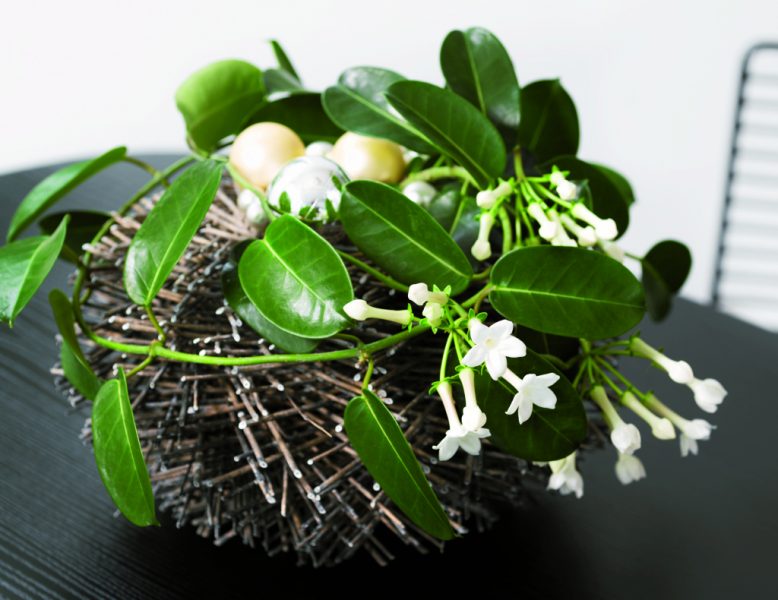
Exotic flower due to its origin and structure has a number of features that should be considered when growing:
- The size of the plant, requiring significant space, which is difficult to ensure in small spaces.
- The need for plentiful watering and a high level of humidity.
- Photophilous culture.
- The length of the flowering period during which fragrant flowers bloom.
In the absence of knowledge about the nuances of growing a crop at home and non-compliance with the rules for caring for it, the grower may encounter some difficulties.
Stefanotis does not bloom
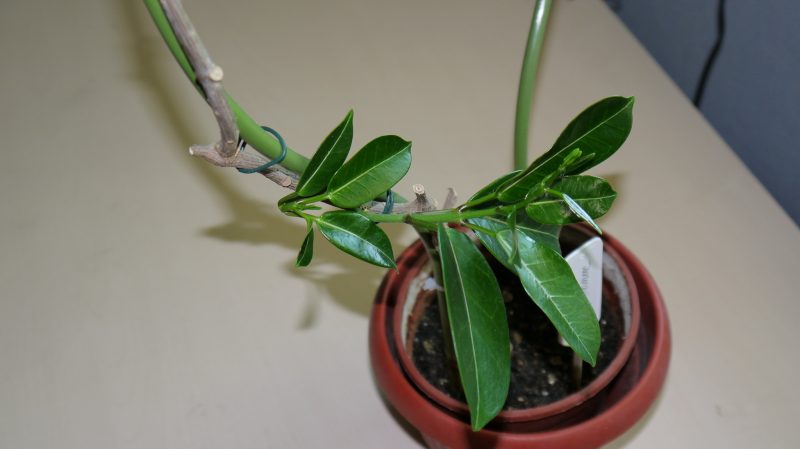
There may be several reasons for the lack of flowers on an evergreen vine:
- lack of dormancy in the winter;
- an excess of nitrogen;
- lack of lighting;
- the presence of sudden changes in temperature, leading the plant into a stupor.
Having identified a factor that negatively affects the full development of culture, the grower will be able to eliminate the problem and no longer make mistakes.
Stefanotis leaves turn yellow
The appearance of yellowness on the leaf plates of the flower is a signal for a review of the conditions of detention and care measures.
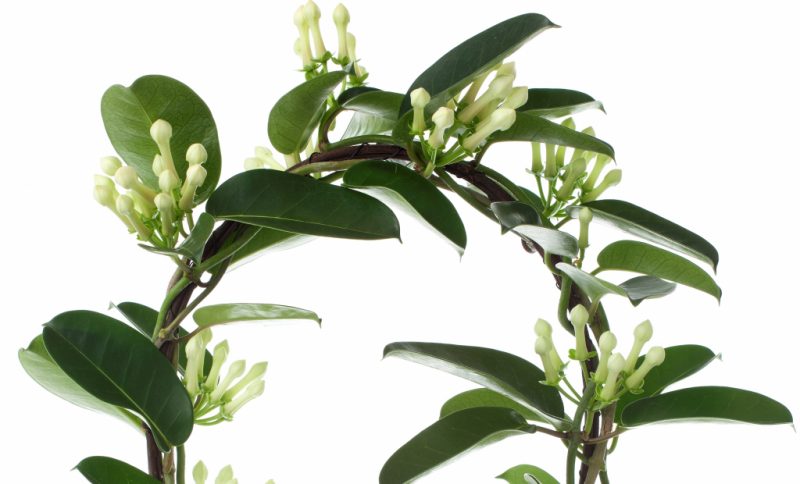
Yellowing of the culture may be associated with such negative factors:
- untreated water for irrigation, which contains lime in high concentration;
- illiterate approach to choosing a place and, as a result, oppression of culture due to the constant lack of bright lighting;
- soil depletion due to insufficient feeding;
- reaction to a transplant, in which the root system was disturbed or even injured.
The creeper falls
If the process is observed from mid-autumn after the reduction of daylight hours, then this is a natural reaction of stefanotis to light deficiency.

If a similar problem is noted in the spring, when the flower should actively grow green mass, then the reason lies in the hypothermia or draft, which are often exposed to plants located near windows that open for ventilation.
Stefanotis care at home
To please the capricious flower from exotic places, it is necessary to provide him with optimal conditions of detention and carry out comprehensive care.
Ground and pot requirements

In order for the plant to feel comfortable, its root system must be in a fairly tight container with good drainage. The substrate for stefanotis is used heavy with a neutral or slightly acidic reaction. You can prepare the soil mixture with similar indicators by mixing peat, humus, sand, clay and leafy soil in a ratio of 3: 3: 2: 1: 1.
Temperature, humidity and lighting
Knowing the fast growth rate of a branchy vine and its photophilousness, narrow window sills should be immediately deleted from the list of possible places for plant placement. The best option for installing a pot with a beautiful flower is large windows on the west side of the house, which will provide the necessary amount of soft light. With the advent of autumn, when nights will become much longer than the day, additional light sources in the form of fluorescent lamps are organized for stephanotis.
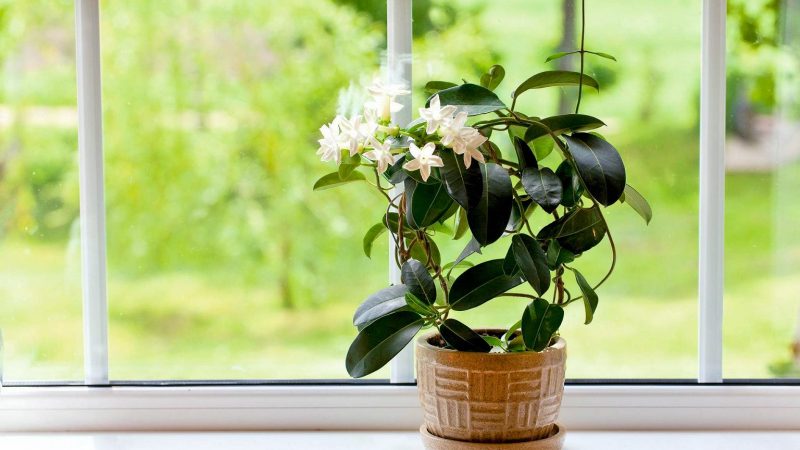
The optimal temperature regime for stefanotis depends on the phases of development occurring at different times of the year:
- During the period of intensive growth (spring - summer), the optimum temperature values can vary in the range of 20 - 25 ° C.
- In the dormant phase (late autumn - winter), stefanotis needs to be in a room with a temperature of 15 ° C, which will provide further abundant and prolonged flowering.
Important! Do not allow the temperature to drop below 14 ° C: this can lead to hypothermia of the flower.
A representative of the rainforest needs a constant level of humidity with a high rate. To create an optimal microclimate, systematic spraying should be carried out using room temperature purified water from lime sediment.
During the period of budding, flowering and dormancy, spraying is replaced by installing a flower pot on a pallet with wet expanded clay.
Watering a flower
Water stefanotis should be plentiful.In the spring-summer period, the procedure is carried out every other day, and in the winter - with an interval of a week. Only irrigation water should be used for irrigation.
Fertilizer and fertilizer

Systematic enrichment of the soil with the nutrients necessary for the full development of the flower is also included in the comprehensive care. In the spring-summer period, mineral fertilizers with a higher concentration of phosphorus and potassium are introduced into the substrate, since nitrogen is only responsible for the development of green shoots.
If the transplant has not been carried out for a long time and the flower grows in depleted soil, then the interval between top dressing should be no more than 20 days.
Transfer
Young specimens are transplanted every spring, but as they grow older, the interval between procedures increases to 3-4 years.
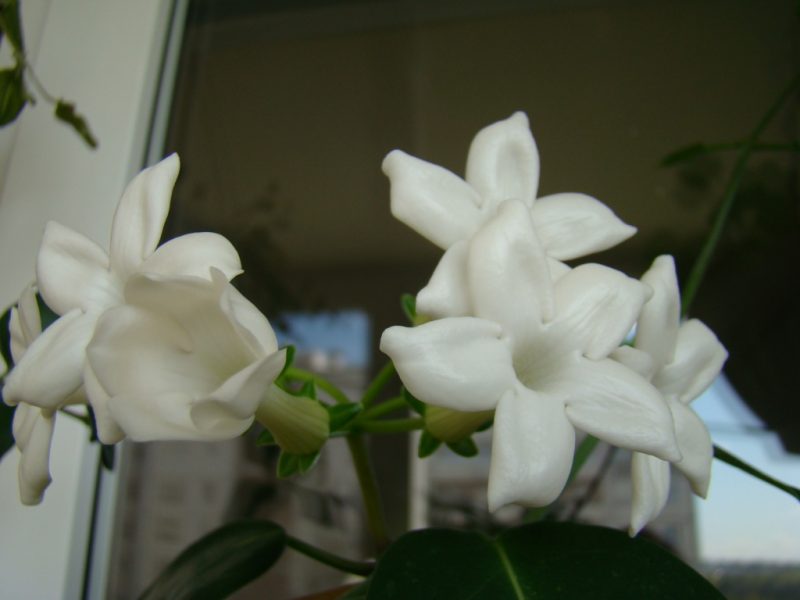
Wherein:
- A container is selected in diameter 2 cm larger than the previous one.
- A layer of drainage material is placed at the bottom.
- Then the flower with an old earthen lump passes.
- A strong support for the liana is installed, capable of supporting the weight of lignified shoots.
- The remaining space is filled with fresh soil mixture rich in essential macro- and microelements.
Secrets of flowering
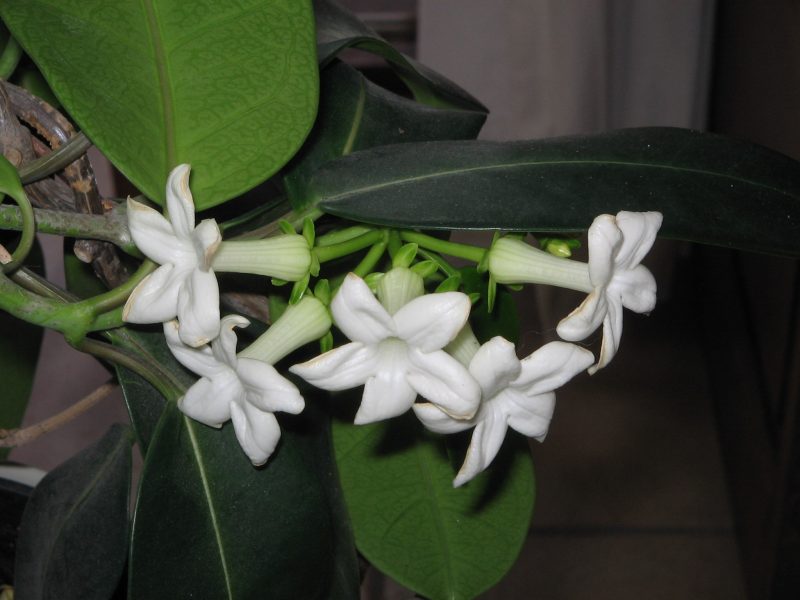
Obtaining abundant flowering is not difficult at all, if you remember that you can’t:
- spray the vine into the phase of budding and blooming of flowers;
- change the position of the pot;
- to allow temperature differences and drafts.
Trimming and shaping a bush

The peculiarity of stefanotis, which consists in the formation of buds only on new shoots, is due to the need for annual pruning, which is carried out in early spring, before the start of active vegetation. To stimulate branching and increase the number of flowers, pinching is performed in the summer.
Winter care
From mid-spring to mid-winter, stefanotis needs a rest, which can be provided:
- moving the flower to a cool place;
- reducing watering;
- stopping fertilizer application.
Diseases and pests - how to treat?
A healthy plant with good immunity is rarely affected by pests and disease. But in violation of the conditions of detention on the flower, aphids, mealybugs or spider mites can be noted on the flower. It is necessary to deal with them by spraying the shoots with an insecticide solution according to the manufacturer's instructions. In case of strong occupancy, the treatment is carried out a second time, two weeks later.
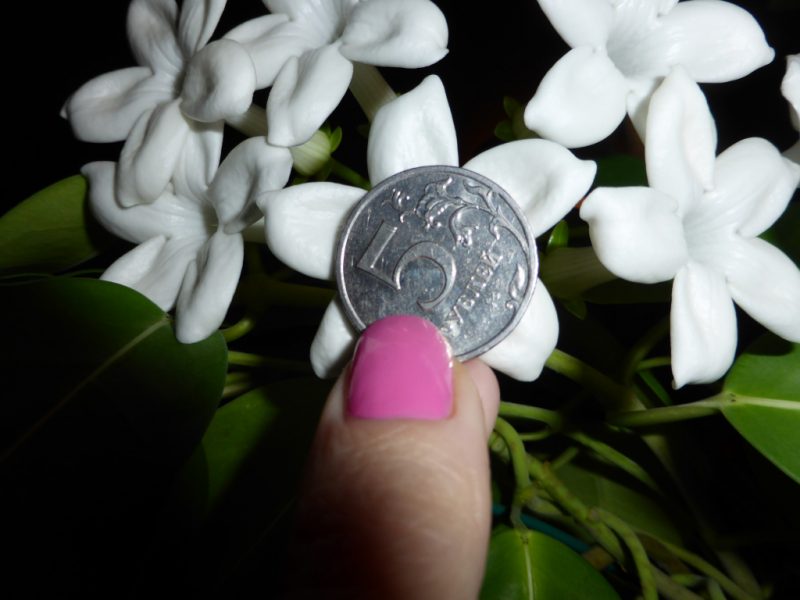
Because of the love of a tropical plant for high humidity, powdery mildew may begin to develop, which can be treated with fungicide and lowering air humidity.
Flower propagation
At home, the most productive and easiest way is to cuttings, in which:
- In early spring, cuttings with 2 to 3 internodes are cut.
- Planting material is aged in a growth stimulator, after which it is buried in a substrate of sand and peat, taken in equal parts.
- Plantings are covered with a film to create a greenhouse microclimate.
- In 1,5 - 2 months after rooting cuttings several pieces are planted in separate pots.
- When the plants reach a half-meter height, pruning is performed to stimulate branching by ⅓ of the length.
Signs associated with the stephanotis flower
People who believe in various signs often ask the question: is it possible to keep a creeper at home? Judging from the point of view of popular superstitions, the answer will be mixed. According to some, stefanotis is a husbandman, and in the house where he grows, an unmarried girl will remain an old maid. According to others, a flowered plant promises an upcoming wedding to a girl who owns a flower.

However, the beautiful and fragrant flower of stefanotis, the signs and prejudices associated with which are completely opposite, still carries one real danger - its juice is poisonous. Therefore, deciding to acquire an evergreen vine, the grower must find a place for it away from children and animals.
Thus, despite all the capriciousness of character, stefanotis becomes a welcome guest in many houses and apartments, where he captivates with its beauty and aroma.












